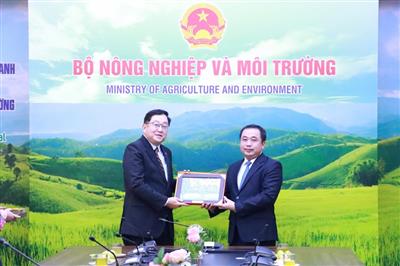
Application of a three-stage aerobic biological rotating cage: A novel approach to urban domestic wastewater treatment
30/09/2025TN&MTDomestic wastewater is one of the most significant environmental pressures in urban areas of Vietnam, particularly in densely populated neighborhoods with limited infrastructure. A recent study by Le Hoang Viet and Nguyen Vo Chau Ngan (Faculty of Environment and Natural Resources, Can Tho University) evaluated a three-stage aerobic biological rotating cage (an improved form of the rotating biological contactor - RBC) using K3 media, demonstrating high treatment efficiency and promising applicability due to its low investment cost and simple operation.

Urban domestic wastewater in Vietnam contains high levels of organics, nitrogen, and phosphorus, while treatment technologies remain limited by high costs and operational barriers
Challenges of domestic wastewater in Vietnam
Urban domestic wastewater in Vietnam contains high concentrations of biodegradable organic matter, nitrogen, and phosphorus—pollutants that, if discharged untreated, degrade surface water quality and threaten public health. Centralized wastewater collection and treatment systems exist only in a few major cities, with limited capacity, insufficient to keep pace with rapid urbanization and population growth. In many residential areas, domestic wastewater continues to be discharged directly into rivers and canals, exacerbating environmental degradation and increasing the risk of waterborne diseases.
Biological treatment technologies are commonly divided into two categories: suspended growth (e.g., activated sludge) and attached growth (e.g., rotating biological contactors). While RBCs have been widely applied in developed countries due to their operational stability and low running costs (Cortez et al., 2006; Grady et al., 1999), in Vietnam and other developing countries their adoption remains limited because of high initial investment, reliance on imported equipment, and challenges in operation and maintenance.
Against this backdrop, there is an urgent need for simple, efficient, and low-cost wastewater treatment solutions tailored to Vietnam’s urban conditions. Responding to this demand, the Can Tho University research team developed an improved approach: a three-stage aerobic biological rotating cage, designed to overcome limitations of conventional systems while retaining the advantages of attached-growth technology.
The three-stage aerobic biological rotating cage model
To address the shortcomings of conventional systems, the research team designed and fabricated a laboratory-scale three-stage aerobic biological rotating cage. The system consists of three sequential compartments with a total working volume of 75.75 liters. Each compartment was filled with K3 polyethylene media (25 mm diameter, 12 mm thickness) with a specific surface area of 500 m²/m³. In total, the media provided approximately 33.3 m² of surface area, ensuring sufficient space for microbial colonization and biofilm development.

Three-stage aerobic biological rotating cage model
The rotating cages were submerged approximately 35% in wastewater, with the remaining surface alternately exposed to air during rotation. This design ensured both direct contact between microorganisms and pollutants and oxygen transfer from the atmosphere to sustain aerobic biodegradation. The chosen rotation speed and submergence depth balanced contact time, oxygen supply, and biofilm stability.
The system operates on the principle of attached aerobic biofilm growth. After an acclimation period of approximately 18 days, a light-brown biofilm layer of 1–3 mm thickness developed on the media, confirming stable microbial activity. During rotation, the biofilm alternately contacted wastewater and air, enabling degradation of organic matter, oxidation of ammonium to nitrate, and assimilation of phosphorus into biomass.
With its three-stage configuration, the system facilitated stepwise treatment: the first stage primarily removed biodegradable organic matter, the second promoted nitrification, and the third completed biochemical reactions, thereby improving effluent quality.
Field experiment in Can Tho city

The model was tested under field conditions in Xuan Khanh ward, Ninh Kieu district, Can Tho city (now Ninh Kieu ward, Can Tho city after administrative consolidation). This densely populated area discharges most domestic wastewater directly into the Tham Tuong Canal without treatment, placing considerable pressure on surface water quality. To ensure representativeness, wastewater samples were collected during morning peak hours (08:00–08:30), when flow and pollutant concentrations are typically highest.
Characteristics of influent wastewater
Influent analysis revealed significant pollution levels:
- BOD₅: 220 mg/L
- COD: 415 mg/L
- N-NH₄⁺: 25.6 mg/L
- N-NO₃⁻: 4.11 mg/L
- TP: 4.5 mg/L
- SS: 71.2 mg/L
All parameters exceeded the limits of QCVN 14:2008/BTNMT (Column A), particularly BOD₅ and COD, confirming the urgent need for treatment in this area.
System operation
The biological rotating cage was operated continuously with a hydraulic retention time (HRT) of 4 hours, ensuring sufficient interaction between wastewater and biofilm. During the start-up phase, after approximately 18 days of operation, a stable biofilm layer 1–3 mm thick had developed on the K3 media. This indicated that aerobic microorganisms were established and capable of degrading organic matter and transforming nutrients. Stabilization of the biofilm marked the point at which the system could deliver consistent performance and produce reliable monitoring data.
Key research findings
Performance evaluation after stabilization showed that the three-stage aerobic biological rotating cage achieved high removal efficiencies:
- BOD₅: 216.7 → 21.8 mg/L (89.9% removal)
- COD: 415 → 61.8 mg/L (96.7%)
- N-NH₄⁺: 27.6 → 2.86 mg/L (89.6%)
- TP: 4.93 → 2.13 mg/L (56.8%)
- SS: 71.8 → 33.2 mg/L (53.7%)
- N-NO₃⁻ increased from 6.02 to 14.8 mg/L, indicating effective nitrification.
The treated effluent met QCVN 14:2008/BTNMT (Column A) standards, confirming compliance for environmental discharge.
These results underscore the advantages of the three-stage aerobic biological rotating cage in domestic wastewater treatment. The system achieved high removal efficiencies, particularly for organic matter and ammonium. Moreover, the short HRT of only 4 hours is considerably lower than that required by many other biological technologies, enhancing flexibility and process efficiency. The model is also operationally simple, requires minimal technical expertise, and involves low costs, making it suitable for deployment in residential clusters, small and medium-sized towns, and other areas lacking centralized treatment systems.
Nonetheless, the study identified certain limitations. Phosphorus removal was moderate (56.8%), suggesting that supplemental processes—such as chemical precipitation or specialized media—may be needed to enhance performance. Additionally, since the experiment was conducted at small scale, further evaluation is required to assess hydraulic and organic loading capacities in full-scale applications. Finally, while sludge generation was lower than in activated sludge systems, residual sludge still requires proper collection and management.
Significance and prospects for application
The study confirms that the three-stage aerobic biological rotating cage is a feasible solution for domestic wastewater treatment in Vietnam. With its simplicity, low cost, short HRT, and stable treatment performance, the technology is well suited for medium-sized cities, residential clusters, and rural communities where sewerage and centralized treatment plants are lacking.
According to the authors, implementing this model not only mitigates surface water pollution but also contributes to green infrastructure development and circular economy practices in wastewater management. This aligns with Vietnam’s sustainable development strategies and supports national commitments to greenhouse gas emission reduction, particularly in the context of climate change and rapid urbanization.
The promising initial results highlight the potential for scaling up and practical application in diverse contexts. However, further research is required on full-scale system performance, phosphorus removal optimization, and sludge management to refine the technology into a sustainable and context-appropriate solution for wastewater treatment in Vietnam.
Minh Thao
Source: Proceedings of the 2nd National Scientific Conference on “Agricultural and Rural Environment and Sustainable Development.
















